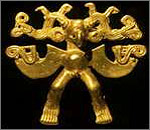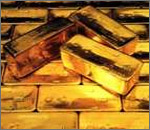Gold occurs alone or in admixture with other ores. It is soft and easily worked, and does not react chemically in most circumstances. It is largely immune from tarnishing or other surface de

terioration.
Thus from earliest times gold has been considered to be "incorruptible," and has been treasured as much for that (and the associated symbolism) as for its comparative rarity and its surfaceglitter.
However gold is quite soft, and gold objects are accordingly rather weak. Therefore it is usually either alloyed with other metals (such as copper) or used as a surface covering on objects made of sturdier (and cheaper) material.Gold hammered into thin sheets can be hammered over or into a mold to produce a bas-relief design, a process known as repoussé. (Less commonly repoussé is produced by placing the gold sheet on a soft surface and striking it with a hammer bearing the desired design.)
The high cost and comparative softness of gold means that many ancient objects, such as crowns, bracelets, and burial masks, were made this way. Unfortunately, they were quite fragile and foil-like, and in archaeological contexts one often finds that they have been crushed or crumpled.
Gold can be worked into even thinner sheets and applied as foil — gold leaf — to produce a thin metallic veneer on objects made of wood or other material, and indeed that is perhaps its most common form archaeologically. This allows the possibility of using gold as a surface on internal and external architectural details, from palace door frames to roofs of temples, as well as smaller

objects ranging from cosmetic jars to book covers.
In modern times, the process of electroplating allows the application of a layer of gold as thin as a single atom deep on appropriately receptive surfaces. Thus a very thin layer of gold isnow used to improve the conductivity of computer connections, as a plating on even relatively cheap jewelry, or as a thin overlay on sashimi eaten as a status symbol by pretentious Japanese businessmen.
Lumps of gold, in contrast, are extremely dense and heavy. Many Chinese believe that eating a lump of gold was an aristocratic method for committing suicide in imperial times, since the heavy lump would overwhelm the digestive track and produce internal bleeding and death.


